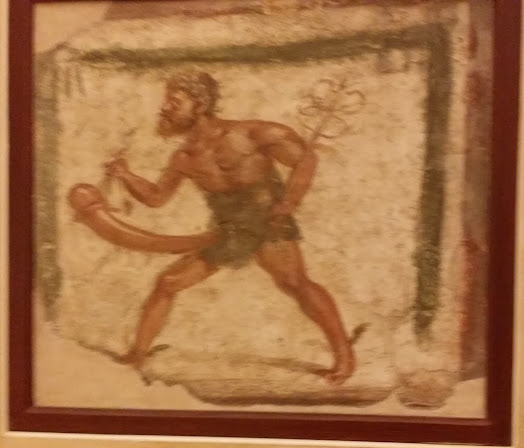Naples
We both had rather negative memories of Naples from the 1970's. But it was like a different city. Now Naples seems to be thriving there is no evidence of the crime wave that once brought the city down. Indeed there are tourist friendly police everywhere. The people are friendly, no longer distant and suspicious. The city is clean and interesting.
After returning from Pompeii we spent several hours in the National Archaeological Museum (Museo Archeologico Nazionale) in Naples, viewing original items, mosaics and murals, many from Pompeii, although not everything was on display.
Among those that are is a large collection of erotic art from Pompeii and Herculaneum some of it from private homes. It's not clear if this preoccupation with sex was limited to the resort towns or not - like the British seaside love of 'dirty postcards'. No other Roman towns from before the advent of Christianity remain in tact.
A fraction of the non-erotic collection
Everyday images decorating walls in homes like sculptures in public places frequently illustrated some myth and the characters semi-nude. But nudity is represented in many homes and art galleries today. It doesn't mean that we all run around naked nor do I imagine did they. The unusual difference is that we usually keep what we might term pornography in a bottom draw, whereas they seemed to be happy to display it.
Thus, modesty prohibits me showing you more than a small sample of the Roman erotic images:
 |
 |
As a change from the museum we dropped in to the cathedral. It was a lonely experience.
Cathedral interior - repairs are under way to prevent it falling down
Among the other interesting things in Naples is the underground chambers. We took a tour of the city underground including some buried Roman ruins - a theatre at which Nero performed - now partly incorporated into Neapolitan houses.
It is said that in order to construct the city walls a rather unique quarry was found. Blocks of stone were cut from the rock underling the city then hoisted to the surface through shafts. This generated a series of huge interconnected underground chambers that became cisterns for storing water against a possible siege. The trouble was that the shafts used during construction doubled as wells and as garbage disposals. What better place to dispose of a body? Initially there were people charged with keeping the water clean but at some point this service failed and the garbage took over. The stench from underground must have been appalling.
Jump forward to 1940 and Italy under Mussolini and the Fascists had declared war on Britain and invaded Egypt and Greece. In consequence Naples had come under air attack from the RAF based in Malta. Following the German lead, allied bombing during WW2 deliberately targeted economic infrastructure including skilled workers and other key civilians, in other words: cities, as a way of bringing the enemy to its knees.
Although it was not like Tokyo, Hiroshima, Nagasaki, Berlin or even Dresden, Naples would become the most bombed Italian city and suffer between 20 and 25 thousand civilian casualties, about the same as Dresden. By 1943 there was on average a British or American air raid on the city every second day. Air raid shelters were needed but the readymade underground chambers were full of rotting garbage. The solution was to press it down and pour concrete over the whole mess.
The constant raids had the desired effect. As it became apparent that the war had turned against them, the people of Naples would turn on the Fascists and their Nazi allies and hasten the beginning of the end of the war in Europe.
Naples Underground
Today tourists can wander about in these historic underground chambers, on slightly undulating concrete floors, and not a hint of the entombed garbage remains. Among some wartime memorabilia there are experiments growing different plants under lights and a convent's wine cellar that once occupied one of the underground chambers.
Naples Above Ground
We left by train for Florence full of enthusiasm for Naples.
